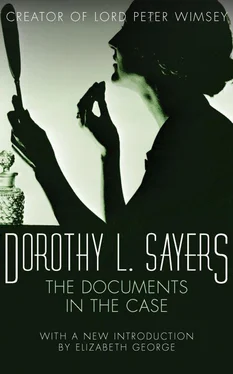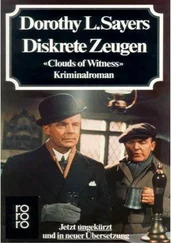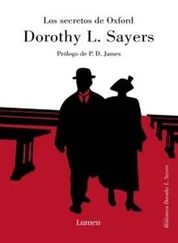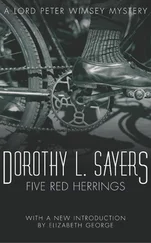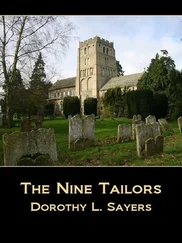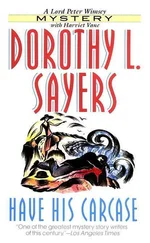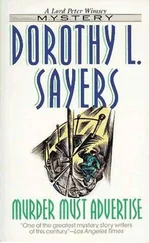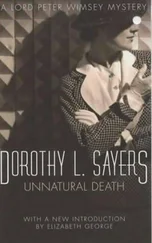Dorothy L. Sayers
The Documents in the Case
Contents
Introduction by Elizabeth George
Introduction
Section One — Synthesis
Section One — Synthesis cont'd
Section Two — Analysis
Section Two — Analysis con'td
INTRODUCTION by Elizabeth George
I came to the wonderful detective novels of Dorothy L. Sayers in a way that would probably make that distinguished novelist spin in her grave. Years ago, actor Ian Carmichael starred in the film productions of a good chunk of them, which I eventually saw on my public television station in Huntington Beach, California. I recall the host of the show reciting the impressive, salient details of Sayers’ life and career — early female graduate of Oxford, translator of Dante, among other things — and I was much impressed. But I was even more impressed with her delightful sleuth Lord Peter Wimsey, and I soon sought out her novels.
Because I had never been — and still am not today — a great reader of detective fiction, I had not heard of this marvellous character. I quickly became swept up in everything about him: from his foppish use of language to his family relations. In very short order, I found myself thoroughly attached to Wimsey, to his calm and omnipresent manservant Bunter, to the Dowager Duchess of Denver (was ever there a more deliciously alliterative title?), to the stuffy Duke and the unbearable Duchess of Denver, to Viscount St George, to Charles Parker, to Lady Mary. . In Dorothy L. Sayers’ novels, I found the sort of main character I loved when I turned to fiction: someone with a ‘real’ life, someone who wasn’t just a hero who conveniently had no relations to mess up the workings of the novelist’s plot.
Dorothy L. Sayers, as I discovered, had much to teach me both as a reader and as a future novelist. While many detective novelists from the Golden Age of mystery kept their plots pared down to the requisite crime, suspects, clues, and red herrings, Sayers did not limit herself to so limited a canvas in her work. She saw the crime and its ensuing investigation as merely the framework for a much larger story, the skeleton — if you will — upon which she could hang the muscles, organs, blood vessels and physical features of a much larger tale. She wrote what I like to call the tapestry novel, a book in which the setting is realised (from Oxford, to the dramatic coast of Devon, to the flat bleakness of the Fens), in which throughout both the plot and the subplots the characters serve functions surpassing that of mere actors on the stage of the criminal investigation, in which themes are explored, in which life and literary symbols are used, in which allusions to other literature abound. Sayers, in short, did what I call ‘taking no prisoners’ in her approach to the detective novel. She did not write down to her readers; rather, she assumed that her readers would rise to her expectations of them.
I found in her novels a richness that I had not previously seen in detective fiction. I became absorbed in the careful application of detail that characterised her plots: whether she was educating me about bell ringing in The Nine Tailors , about the unusual uses of arsenic in Strong Poison , about the beauties of architectural Oxford in Gaudy Night . She wrote about everything from cryptology to vinology, making unforgettable that madcap period between wars that marked the death of an overt class system and heralded the beginning of an insidious one.
What continues to be remarkable about Sayers’ work, however, is her willingness to explore the human condition. The passions felt by characters created eighty years ago are as real today as they were then. The motives behind people’s behavior are no more complex now than they were in 1923 when Lord Peter Wimsey took his first public bow. Times have changed, rendering Sayers’ England in so many ways unrecognisable to today’s reader. But one of the true pleasures inherent to picking up a Sayers novel now is to see how the times in which we live alter our perceptions of the world around us, while doing nothing at all to alter the core of our humanity.
When I first began my own career as a crime novelist, I told people that I would rest content if my name was ever mentioned positively in the same sentence as that of Dorothy L. Sayers. I’m pleased to say that that occurred with the publication of my first novel. If I ever come close to offering the reader the details and delights that Sayers offered in her Wimsey novels, I shall consider myself a success indeed.
The reissuing of a Sayers novel is an event, to be sure. As successive generations of readers welcome her into their lives, they embark upon an unforgettable journey with an even more unforgettable companion. In time of dire and immediate trouble, one might well call upon a Sherlock Holmes for a quick solution to one’s trials. But for the balm that reassures one about surviving the vicissitudes of life, one could do no better than to anchor onto a Lord Peter Wimsey.
Elizabeth GeorgeHuntington Beach, CaliforniaMay 27, 2003
INTRODUCTION
Paul Harrison to Sir Gilbert Pugh [Letter covering the attached documents.]
Redgauntlet Hotel, Bloomsbury, W.C.18th March, 1930
Dear Sir,
I am obliged by your letter of yesterday’s date, and hasten to send you, as requested, the complete dossier of documents. When you have read them, I shall be happy to call upon you at any time convenient to yourself, and give you any further information that may be within my power.
All the points I specially wished to make are, I think, fully covered by my previous letter. But since that letter has now served its original purpose of arousing your interest in the matter, I feel that it would be better forgotten, as far as possible. I would rather you came to the present documents with an entirely open mind. To me, who have been working over them for the last six or seven months, they seem to point clearly to one and only one conclusion, but I suppose it is possible that both Sir James Lubbock and I may be mistaken. You will judge for yourself. I only most earnestly beg of you to give the case your most careful consideration. You will realise that it is of vital importance to me to have the matter fully investigated.
You will, I fear, find some of the letters and statements very diffuse and full of irrelevancies. I thought it best to send the originals, complete and untouched, exactly as they stand. Many of the incidental details, though unimportant in themselves, throw useful sidelights on the situation, and will, I think, help a stranger like yourself to understand exactly what took place in my late father’s household.
I have arranged the papers, as nearly as possible, in chronological order. My own statement (Number 49) explains fully how the various documents came into my hands.
Trusting to hear further from you in due course,I am, dear sir,
Yours faithfully, Paul Harrison
1
Synthesis
1. Agatha Milsom to Olive Farebrother
15, Whittington Terrace, Bayswater 9th September, 1928
My dear Olive,
Thank you very much for your letter and kind inquiries after my health. I like my new doctor very much indeed. I think he understands me a great deal better than Dr Coombs, and he has put me on quite a different treatment. He says I am just going through a ‘difficult phase’ at present, and that if only I can hold on and not let things get on top of me for the next year or two I shall come out of it quite all right. But I am not to have a rest-cure! It seems Dr Coombs was all wrong about that — of course he didn’t exactly say she was wrong, it wouldn’t be professional, but I could see that he thought
Читать дальше
